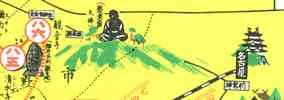

 |  |
 Not far from Nagoya, down the Chita peninsula a little, you come to Toukai. (It can be reached on the Meitetsu local rail line'sTokoname service; the stop is Shurakuen.) There resides the early Showa-period figure of Amida Buddha, the first hollowdaibutsu constructed of reinforced concrete over a steel frame. He received the current bronze color, according to Naoki-san (see references, below) during renovations in 1986. Gazing from his hilltop, Amida overlooks the adjoining park (Shuurakuen) on the east side and one of the Aichi Steel works on the west, in the direction of the Bay of Ise. With a height of 18.79m, the daibutsu looms with a massive presence that can make babies cry. Not far from Nagoya, down the Chita peninsula a little, you come to Toukai. (It can be reached on the Meitetsu local rail line'sTokoname service; the stop is Shurakuen.) There resides the early Showa-period figure of Amida Buddha, the first hollowdaibutsu constructed of reinforced concrete over a steel frame. He received the current bronze color, according to Naoki-san (see references, below) during renovations in 1986. Gazing from his hilltop, Amida overlooks the adjoining park (Shuurakuen) on the east side and one of the Aichi Steel works on the west, in the direction of the Bay of Ise. With a height of 18.79m, the daibutsu looms with a massive presence that can make babies cry. Although the site is not a temple, the daibutsu is a natural stopping place for people on pilgrimage. On the "Aichi Shikoku guide to pilgrimage" map, of which a portion is shown, above right, he is shown as near stop #86 of the 88-temple circuit of the Chita peninsula of Aichi Prefecture. Nowadays the buddha is visible throughout the park and at a distance. According to Ishida-san, with reference to the period just before World War II, the buddha used to be surrounded by pines which came to the height of his shoulders, so only his head and neck projected above them. Those trees were cut down during World War II. (Compare the photos on the next page.) The monument was begun in 1924 and completed in 1927, sponsored by a Nagoya entrepreneur, Yamada Saikichi—who is modestly memorialized at the site. Yamada, characterized at Naoki-san's site as a "typical Meiji success story," began as a pioneer in canned pickled vegetables and later was able to pursue his interest in architecture. The daibutsu was built at the very time that Japan's first steel and reinforced concrete building was being completed (a Tokyo apartment house), and Yamada's interest in this new technology was sharpened by the destruction of two of his own buildings (by fire and by typhoon). The statue was dedicated in commemoration of the wedding the Showa Emperor, which had taken place on January 26, 1924. However, Naoki-san points to both Yamada's piety and his talent at organization and promotion and holds that the ultimate purpose was to draw tourists/pilgrims. He points to the use of wooden daibutsu as "visitor attractions" in the late Edo and early Meiji periods. Access to the inside, through a door at the rear of the daibutsu's base, has been barred for some time. In pre-war days, at least, if not later, one could go in and view "many Buddhist pictures and Buddhist painting on the wall" (Ishida-san). More photos and information can be found in the list of references below.  the view of Aichi Steel from the west side of the daibutsu REFERENCES
|
| Copyright © 2003 C.J. Brunner | | | | Comments or questions? Contact: Kurisu |